江島神社(藤沢) / Enoshima Shrine in Fujisawa
日本三大弁天の1つ江島神社。3姉妹の3つの弁天神社。岩屋洞窟で天然クーラー。美味しい食べ物もいっぱい。/ Eshima Shrine, one of the three biggest benten in Japan. Natural cooler in Iwaya cave. Lots of delicious food.
神奈川県藤沢市にある「江島神社」(えのしまじんじゃ)は、「鎌倉江ノ島七福神」の一人「弁財天」が祀られています。今回まで3、4回は来ているのですが、知らなかったこととして、ここは、「日本三大弁天」の一つということです。
The “Enoshima Shrine” in Fujisawa City, Kanagawa Prefecture, is enshrined with “Benzaiten” God, one of the “Kamakura Enoshima Seven Lucky Gods”. I have been here three or four times, but what I didn’t know is that it is one of the three biggest Benzaiten shrine in Japan.
「日本三大弁天」は、以下の通りです。
“The Three biggest Benten shrines in Japan” are as follows.
- 宝厳寺・竹生島神社(滋賀県 竹生島)(HP)
- 江島神社 (神奈川県 江の島)
- 大願寺・厳島神社 (広島県 厳島)
- Hogonji/Chikubujima Shrine (Chikubu Island, Shiga Prefecture)
- Eshima Shrine (Enoshima, Kanagawa Prefecture)
- Daiganji Temple and Itsukushima Shrine (Itsukushima, Hiroshima Prefecture)
私は、「竹生島神社」が未参拝ですね。是非機会があれば行ってみたいものです。(昨年滋賀県比叡山までは行ったのだけど)
I haven’t visited “Chikubujima Shrine”. I would love to go if I have the opportunity. (I went to Mt. Hiei last year in Shiga prefecture)
この日は、関東の梅雨明け宣言日で、しかも、コロナで打撃を受けた経済立て直し策「Go To トラベルキャンペーン」2回目の週末なので、思ったより人が多かったです。そうここ江ノ島は、観光スポットでした。
There were more people than I expected, because it was the declaration day for the rainy season end in Kanto area, and it was the second weekend of the “Go To Travel Campaign” economic recovery plan against economic reccession by corona virus. So here Enoshima was a tourist spot.
■目次
- 江ノ島駅~江の島弁天橋 / From Enoshima station to Enoshima Benten Bridge
- 青銅の鳥居 / Seido no torii (bronze gate)
- 瑞心門 / Zuishi Gate
- 弁財天童子石像 / Stone statue of Benzai and Tendo children
- 手水舎 / Temizuya to purify
- 辺津宮(下之宮) / Hetsumiya (Shimonomiya)
- 奉安殿(弁天堂) / Hoan-den (Bentan-do)
- 八坂神社 / Yasaka Shrine
- 稲荷社・秋葉社 / Inarisha Akibasha
- 猿田彦大神碑 / Stone Monument of Sarutahiko
- みどりの広場 / Midori no Hiroba (Green Square)
- 中津宮 / Nakatsumiya
- 江の島サムエル・コッキング苑と江の島シーキャンドル / Samuel Cocking Garden and Enoshima Sea Candle
- 江の島大師 / Enoshima Daishi
- 山二つ / Two Mountains
- 奥津宮 / Okutsumiya
- 龍宮 / Ryugu
- 龍恋の鐘 / Bell of Dragon’s love
- 稚児ケ淵 / Chigogafuchi
- 江の島岩屋 / Enoshima Iwaya
- まとめ
■江ノ島駅~江の島弁天橋 / From Enoshima station to Enoshima Benten Bridge
江ノ島電鉄に乗り「江ノ島駅」に降り立ちました。なかなかいい雰囲気の駅舎ですね。(いつも車で江ノ島来るので、電車は珍しいです)
I took the Enoshima Electric Railway and got off at “Enoshima Station”. It’s a nice atmosphere station building. (A train is rare because I always come by car to Enoshima)
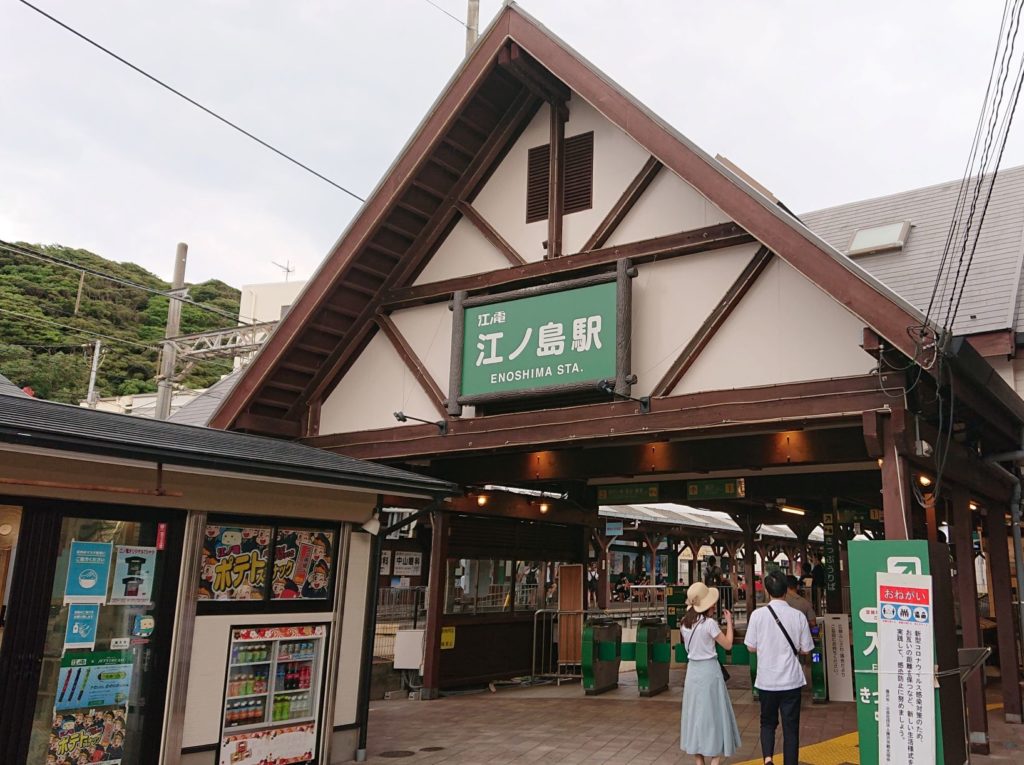
江ノ島駅を出ると、落ち着いて、レンガタイルの細い道の両側に低層の洒落た店の商店街がしばらく続きます。洒落たお店は、以前来た時にあったかは定かではありません。ただ、老舗和菓子屋「中村屋羊羹店」は健在でした。購入を考えたのですが、先日北鎌倉で羊羹買ったので、今回見送りました。
When you leave Enoshima Station, you’ll find a quiet, low-rise fashionable shopping street on either side of a narrow brick tile path. I don’t know if the fashionable store used to be when I came here begore. However, the well-established Japanese confectionery shop “Nakamuraya Yokan shop” was alive and well. I thought about buying yokan (Sweet red beans brick), but the other day I bought yokan in Kita-Kamakura, so I left it off.
江ノ島の方向に向かうと、国道134号線の下を潜る地下道があります。そこを抜けると「江の島弁天橋」(江ノ島大橋)になります。
Heading toward Enoshima, there is an underpass that goes under National Route 134. After passing through it, you can walk on “Enoshima Benten Bridge” (Enoshima Ohashi).
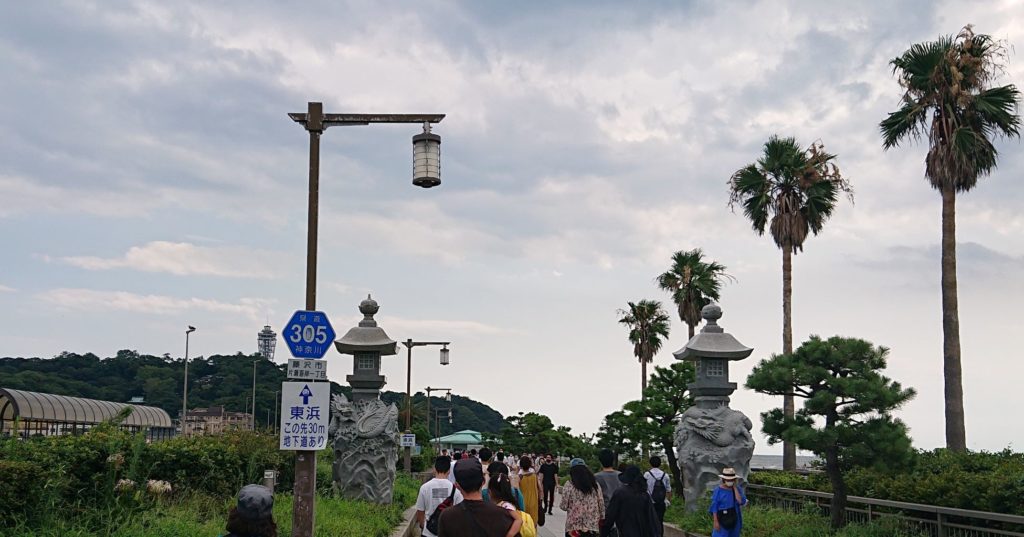
「江の島弁天橋」は、江戸時代にはなく、干潮時に現れる陸を通って江ノ島に入ったそうです。明治時代になって木橋が出来たとのこと。1964年に現在の橋が出来たそうです。(全長389m)
It seems that “Enoshima Benten Bridge” was not in the Edo period. At the time people entered Enoshima through the land that appeared at low tide. It was said that Tree bridge was built in the Meiji era. It seems that the current bridge was built in 1964. (Total length 389m)
以前、横浜美術館で撮影した、開国当時(江戸時代末期)の江ノ島です。歩いて渡っていた頃です。もちろん、周囲に道も家も有りません。漁船のみです。
It is the picture of Enoshima at the opening time of the country (the end of the Edo period), which was previously taken picture at the Yokohama Art Museum. It was around the time people were walking. Of course, there were no roads or houses around. Only fishing boats.

左右には、片瀬江ノ島海岸 東浜と西浜が広がっています。この日も気温が高かったため、人出が少しあります。
To the left and right are the east and west beaches of Katase Enoshima Coast. The temperature was high on this day as well, so there is a little crowd.
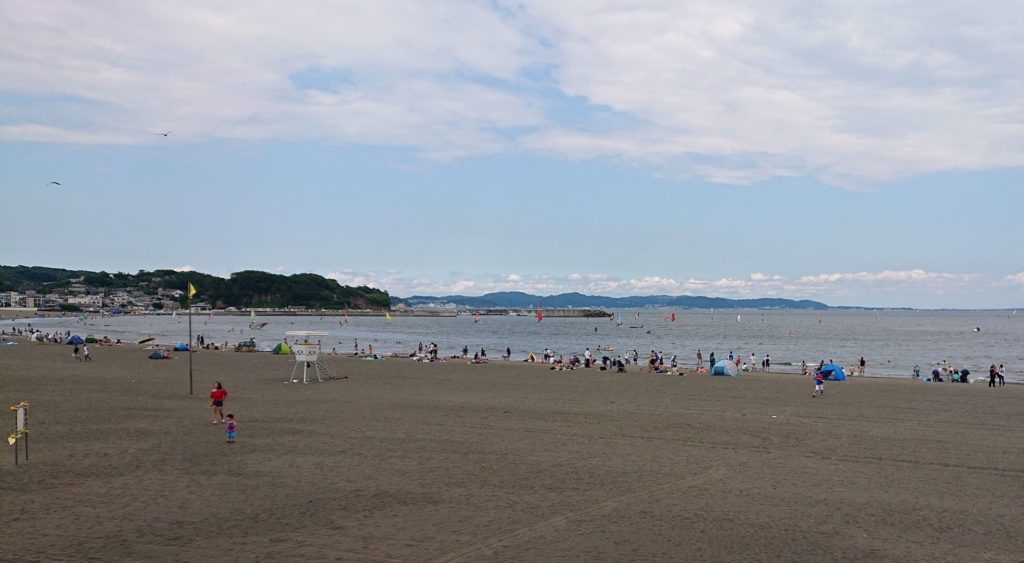

いよいよ「鎌倉江ノ島七福神」の一人「弁財天」様の島に足を踏み入れます。正面に、江ノ島のシンボル「瑞心門」が小さく見えます。
Finally, we will set foot on the island of “Benzaiten”, one of the “Kamakura Enoshima Seven Lucky Gods”. In front of you, you can see the small symbol of Enoshima, “Zuishin Gate”.

■青銅の鳥居 / Seido no torii (bronze gate)
海産物の焼き物の匂いを抜けると「青銅の鳥居」が出迎えます。この「青銅の鳥居」は、1747年に創建、1821年に再建されたものです。再建から200年経っています。鳥居に飾られた「江島大明神」プレート飾りは、鎌倉時代の文永の役(蒙古襲来)に勝利した記念に、後宇多天皇(ごうだ)から贈られた勅額の写しとのこと。本物は、「奉安殿」にあります。
When you go through the good smell of grilled seafood, you will be greeted by the “Seido no torii (bronze gate)”. This “Seido no torii” was built in 1747 and rebuilt in 1821. 200 years have passed since the reconstruction. The “Enoshima Daimyojin” plate displayed on the torii gate is a copy of the royal frame presented by Emperor Gouda to commemorate the victory of the role of Bunei no Eki in the Kamakura era (attack of Mongolia). The real thing is in the “Hoan-den”.
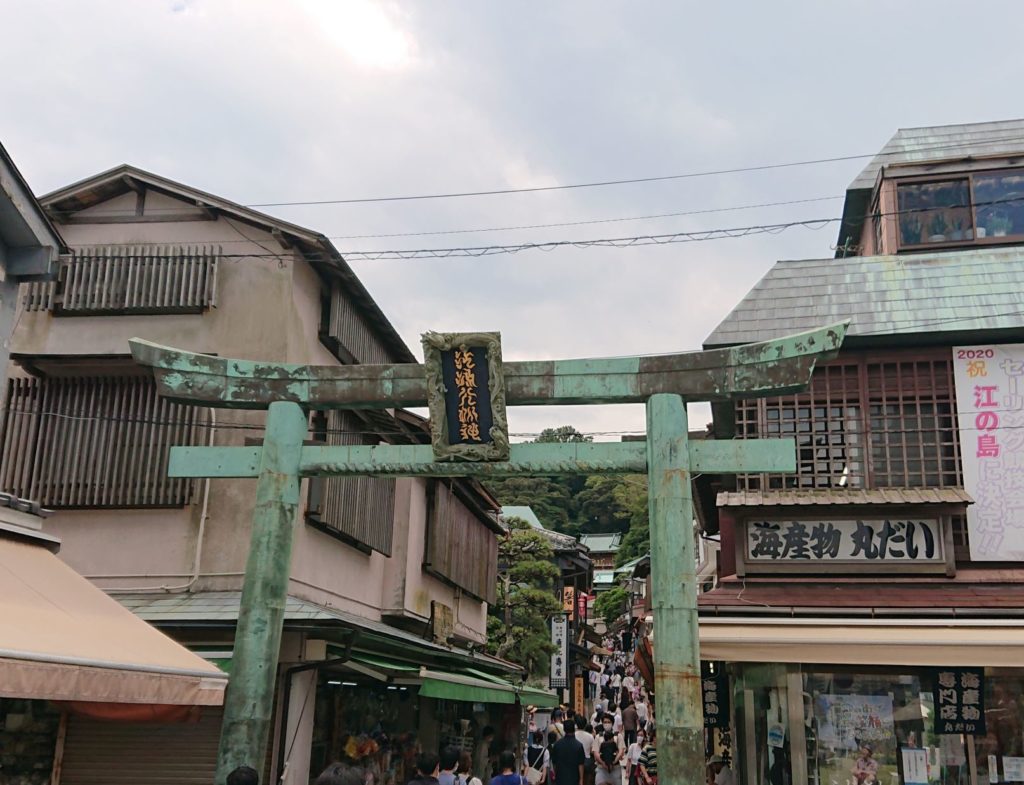
■瑞心門 / Zuishi Gate
商店街では、「しらす」の食堂、「たこせんべい」、「お饅頭」、「かき氷」、「江ノ島ビール」などが売られています。そして、商店街を抜けると、「朱の鳥居」と「瑞心門」が目の前に開けます。江ノ島のシンボル「瑞心門」は、龍宮城を模した楼門です。
In the shopping street, there are “Shirasu (small white fish)” restaurants, “octopus pressed crackers”, “manju”, “shaved ice”, “Enoshima beer”, etc. Then, when you pass through the shopping street, you will find the “Red Torii” and “Zuishin gate” in front of you. The symbol of Enoshima, “Zuishin gate”, is a tower gate imitating Ryugu Castle.

「瑞心門」の壁天井には、片岡華陽が描いた牡丹や唐獅子の絵画が飾られています。唐獅子はご祭神の守護と参拝者に厄災がふりかからないよう、祈願の意味が込められているそうです。
The paintings of Peony and Kara Shishi (Chinese lion) by Kataoka Kayo are displayed on the wall of “Zuishin gate”. It is said that the Kara Shishi has the meaning of prayer so that the worshipers of the festival god and worshipers do not suffer from a disaster.
ここから左に行けば、エスカレーターがありますが、今日は、参拝なので、階段で登ります。
If you go to the left from here, there is an escalator, but today, since it is a worship service, I will climb the stairs.
■弁財天童子石像 / Stone statue of Benzai and Tendo children
「瑞心門」を潜り、階段を上ると正面に「弁財天童子石像」があります。これは平成14年に建立されたものです。平安時代中期の巻物「江嶋縁起」に江ノ島が天下の霊地であることが記されているそうです。欽明天皇の時代に、約10日間天地振動し隆起し江野嶋となった。「天女雲上に顕れ 白龍 十五童子を従え この嶋上に降居したまへり」とあり、弁財天が江ノ島に祀られている理由が右の石板に記されています。そこから1450年(平成14年時)を迎えたそうです。
If you go under “Zuishin gate” and go up the stairs, you will see “Stone Statue of Benzai and Tendo children ” in front. This was built in 2002. It seems that Enoshima is a sacred place in the scroll “Eshima Engi” in the middle of Heian period. During the time of Emperor Kinmei, it vibrated up and down for about 10 days to become Enoshima. There is a message saying, “Female god appeared on the cloud, and White dragon took 15 children, they moved down on Enoshima here”. The reason why Bensaiten is enshrined in Enoshima is written on the stone plate on the right. Since Enoshima birth it has passed 1450 years at 2020.
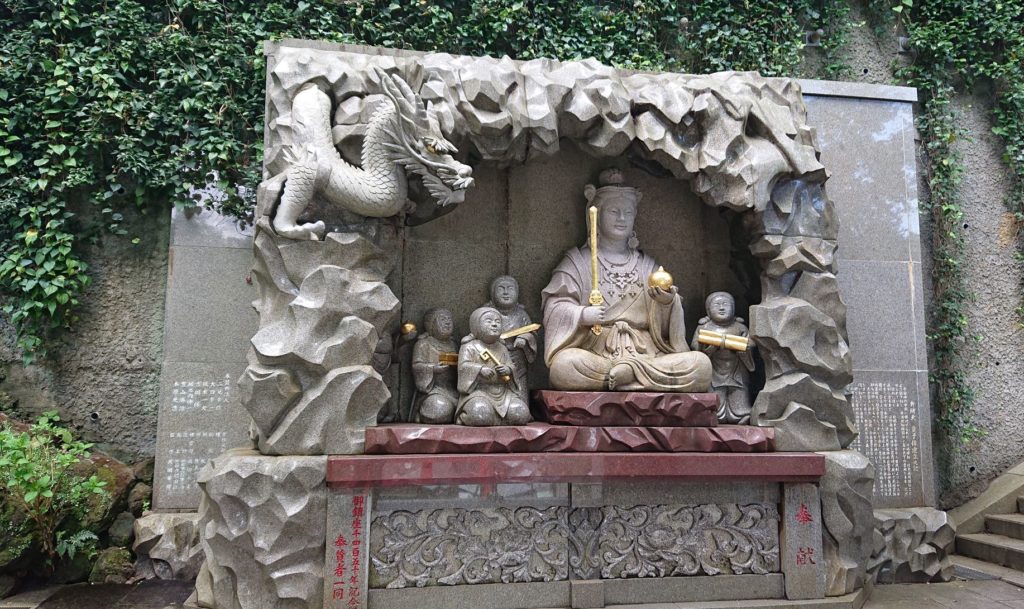
階段を上っていくと、「瑞心門」を見下ろすことができます。
If you go up the stairs, you can see down on “Zuishin gate”.
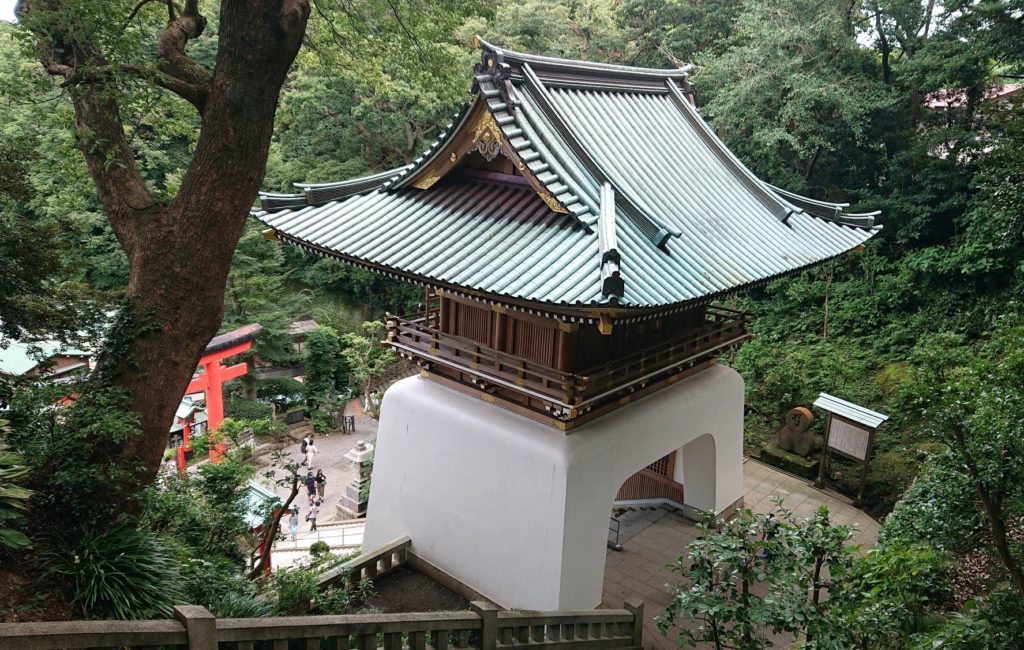
■手水舎 / Temizuya to purify
参拝前の清めの場所です。龍の口から水が出てきます。現在は、コロナ禍で使用禁止です。
It is a purifying place before worship. Water comes out from the mouth of the dragon. Currently, the use is prohibited not to spread of Coronavirus.
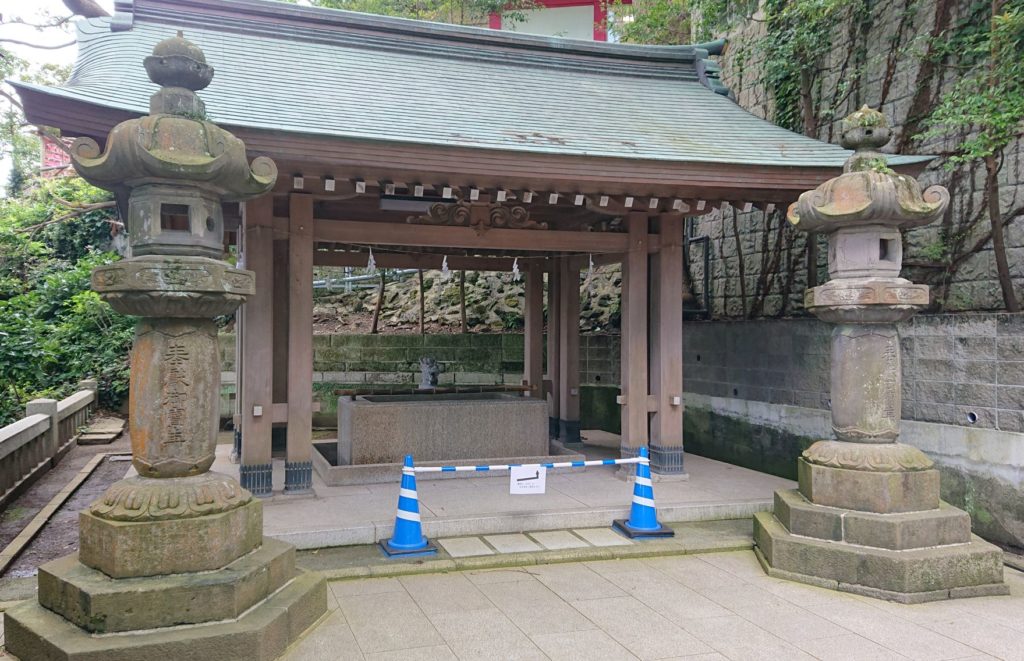
■辺津宮(下之宮) / Hetsumiya (Shimonomiya)
昔「下之宮」と言われていた「辺津宮」(へつみや)です。御祭神は、田寸津比賣命(たぎつひめのみこと)。創建は、1206年 源実朝(みなもとのさねとも)。
It is “Hetsumiya” which was once called “Shimonomiya”. The deity of the festival is Tagitsuhime no Mikoto). It was founded in 1206 by Minamoto no Sanetomo.
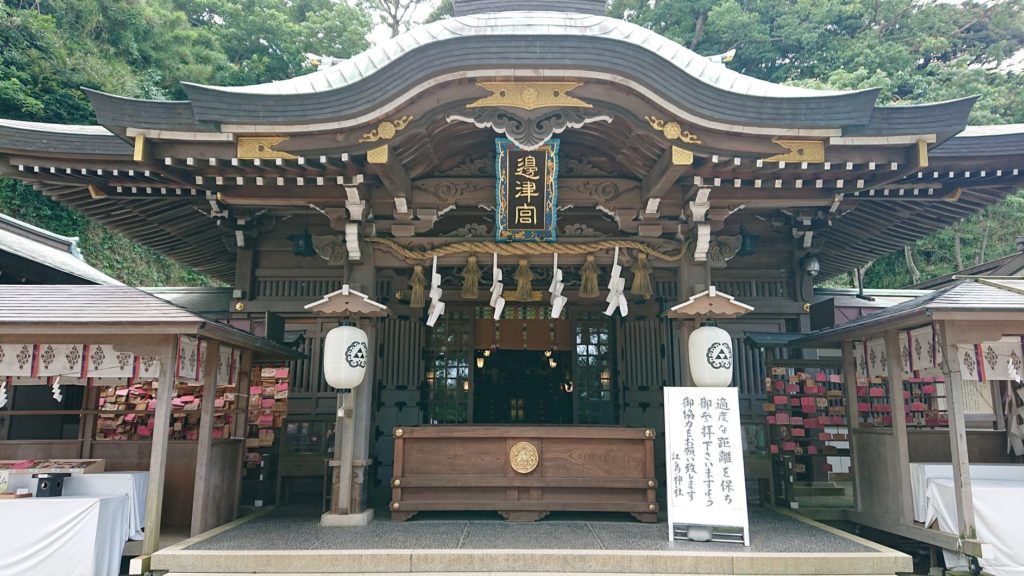
■奉安殿(弁天堂) / Hoan-den (Bentan-do)
「辺津宮」の向かって左にある「奉安殿」には、日本三大弁財天として有名な八臂弁財天(はっぴべんざいてん)(国指定重要文化財)と裸弁財天・妙音弁財天(市指定重要文化財)が祀られています。拝観料200円。
On the left side of “Hetsumiya”, there is “Hoan-den”, which is famous as one of the three biggest Benzaiten in Japan. Happi Benten (National Important Cultural Property) and Naked Benten / Myoon Benten (City Important Cultural property) is enshrined. Admission fee is 200 yen.
「弁財天」は、ヒンドゥー教の女神であるサラスヴァティーが、仏教に取り込まれた呼び名です。「弁財天」は、金光明経(こんこうみょうきょう)を人に説いたり、他者から聞く者に智慧、長寿、富を与えるとされています。
“Benten” is a name that was adopted by Buddhism by the Hindu goddess Sarasvati. “Benten” is said to preach to the people of Konkomyo-kyo (Suvarṇaprabhāsottama-sūtra) and gives wisdom, longevity, and wealth to those who hear from others.
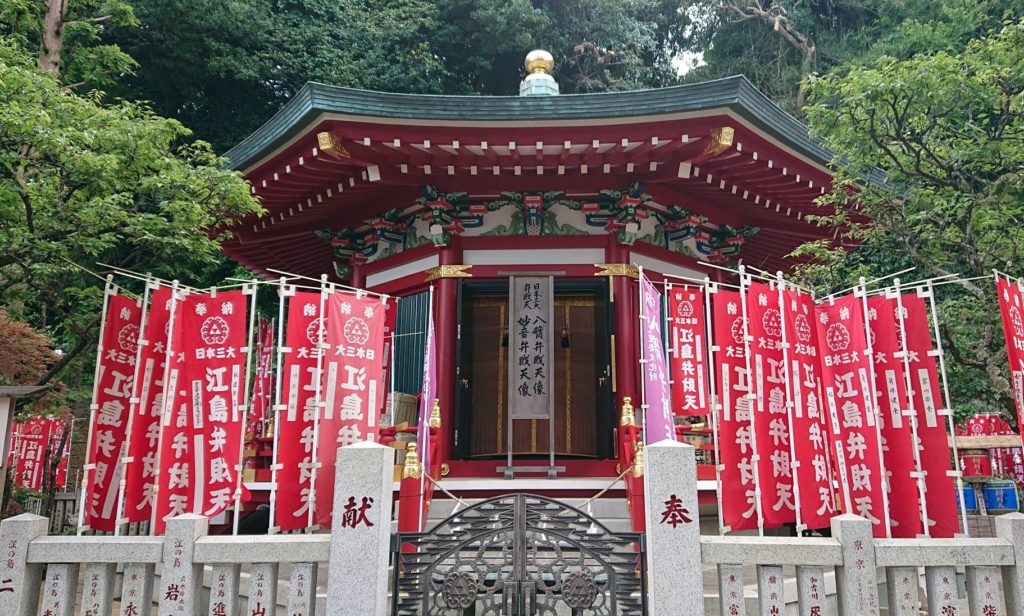
下の写真が、八臂弁財天と裸弁財天・妙音弁財天と15童子になります。
The pictures below are Happi Benten, Naked Benten (Myoon Benten) and 15 children.
「八臂弁財天」は、源頼朝が文覚上人に命じて藤原秀衡をまじないによってのろい殺すことを祈願したと言われています。檜の寄せ木の八つのひじのものとしては最も優れ重要文化財に指定されている。
It is said that “Happi Benten” prayed that Minamoto no Yoritomo ordered the superiors to curse and kill Hidehara Fujiwara. It has been designated as the most important cultural property of the eight elbows of Japanese cypress Parquet.
「裸弁財天・妙音弁財天」は、丈54cm、琵琶を抱え、鎌倉期の名作です。
“Naked Benten/Myoon Benten” is a masterpiece of the Kamakura period, with a length of 54 cm and a biwa.
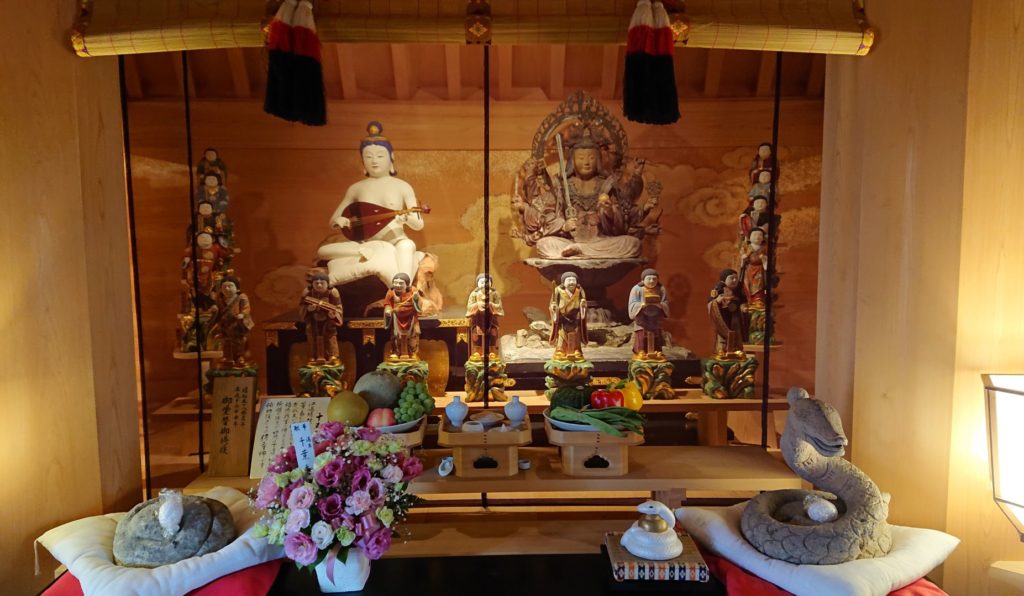
鏡板雲龍図(狩野探雪筆)、江嶋縁起 巻二、インド木彫り弁財天、霊石蛇紋岩、琵琶などが見られます。
You can see Kyoban Unryuzu (by Kano Tansetsu), Enoshima Engi Vol. 2, Indian wood carving Benzaiten, sacred stone serpentine, Biwa, etc.

「青銅の鳥居」にあった後宇多天皇(ごうだ)から賜った「江島大明神」の本物です。後宇多天皇ご御肖像、木造 杉山検校座像、空海手形などが見られます。
It is the real plate of “Enoshima Daimyojin” given by Emperor Gouda. The copy displayer on the “Bronze Torii”. You can see the portrait of Emperor Gouda, a wooden Sugiyama Kenko statue, and a Kukai’s hand print.


■八坂神社 / Yasaka Shrine
建速須佐之男命(たけはやすさのおのみこと)が祀られています。社殿は銅葺の入母屋造りで、江戸時代には天王社として祀られている。御神体は、もともとは、腰越にあったが、大波でさらわれ、海に沈んでいるところを漁師が見つけ、ここに祀ったとのこと。
It is enshrined in Takehaya Susanoo Mikoto. The shrine is built with a copper roof and is enshrined as Tennosha in the Edo period. The God body was shrined in Koshigoe (near Enoshima), but the God body was swept away by the big waves and sunk in the sea. after that it was said that a fisherman found it, and was enshrined here.
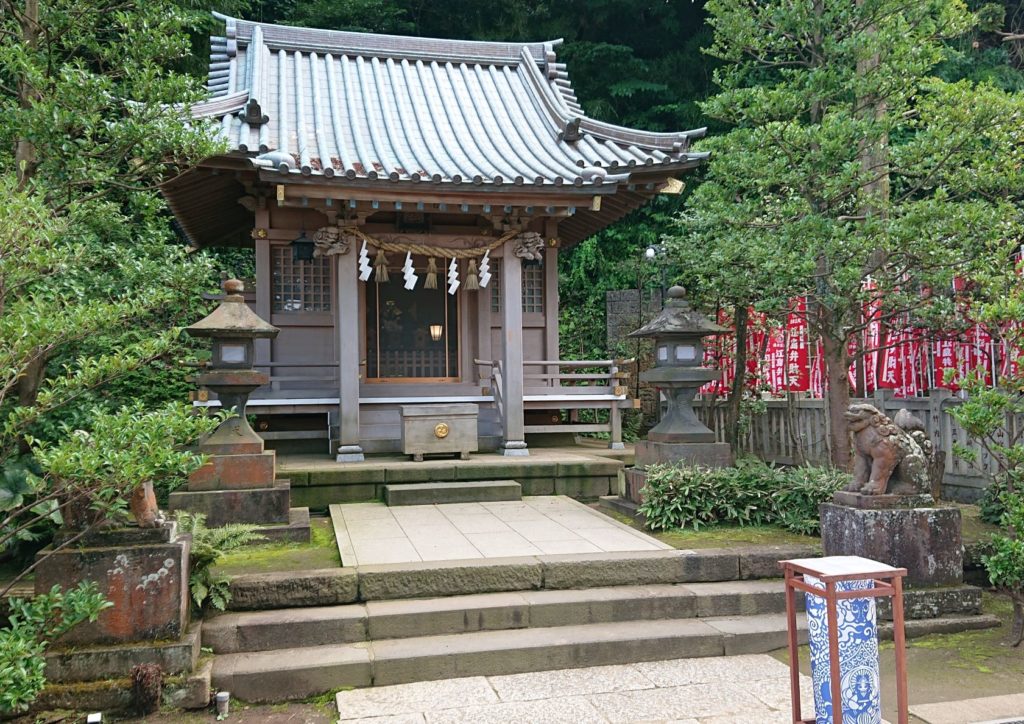
■稲荷社・秋葉社 / Inarisha Akibasha
豊受気毘賣命(とようけひめのみこと)、火之迦具土神(ほのかぐつちのかみ)が祀られています。
It is enshrined with Toyouke Hime no Mikoto and Honokagutsuchi no Kami.
以前は、江の島には、秋葉稲荷・与三郎稲荷・漁護稲荷など多くの小さな稲荷があったようです。それを、ここにまとめたと言われています。
Previously, there seemed to be many small Inari such as Akiba Inari, Yosaburo Inari, and Gyogo Inari. It is said that it was put together here.

■猿田彦大神碑 / Stone Monument of Sarutahiko
1832年、庚申塔の1つとして建てられた。「猿田彦」は、古事記・日本書紀の神話に登場する神で、天孫(ににぎのみこと)が降臨の際に、高千穂まで道案内をした神と言われています。「猿田彦」の「猿」が「庚申塔」の「申」に結びついたと言われています。(干支は、「申」(さる)年といいますね)
It was built in 1832 as one of the Koshinto. “Sarutahiko” is a god that appears in the myths of Kojiki and Nihonshoki , and is said to have guided the way to Takachiho (in Miyazaki pref. of Kyosyu) when his grandson (Ninigi no Mikoto) descended. It is said that the “Saru” of “Sarudahiko” was linked to the “Shin” of “Koshinto”. Both of them mean “Monkey”. (The zodiac is called the “Saru” (Monkey) year.)
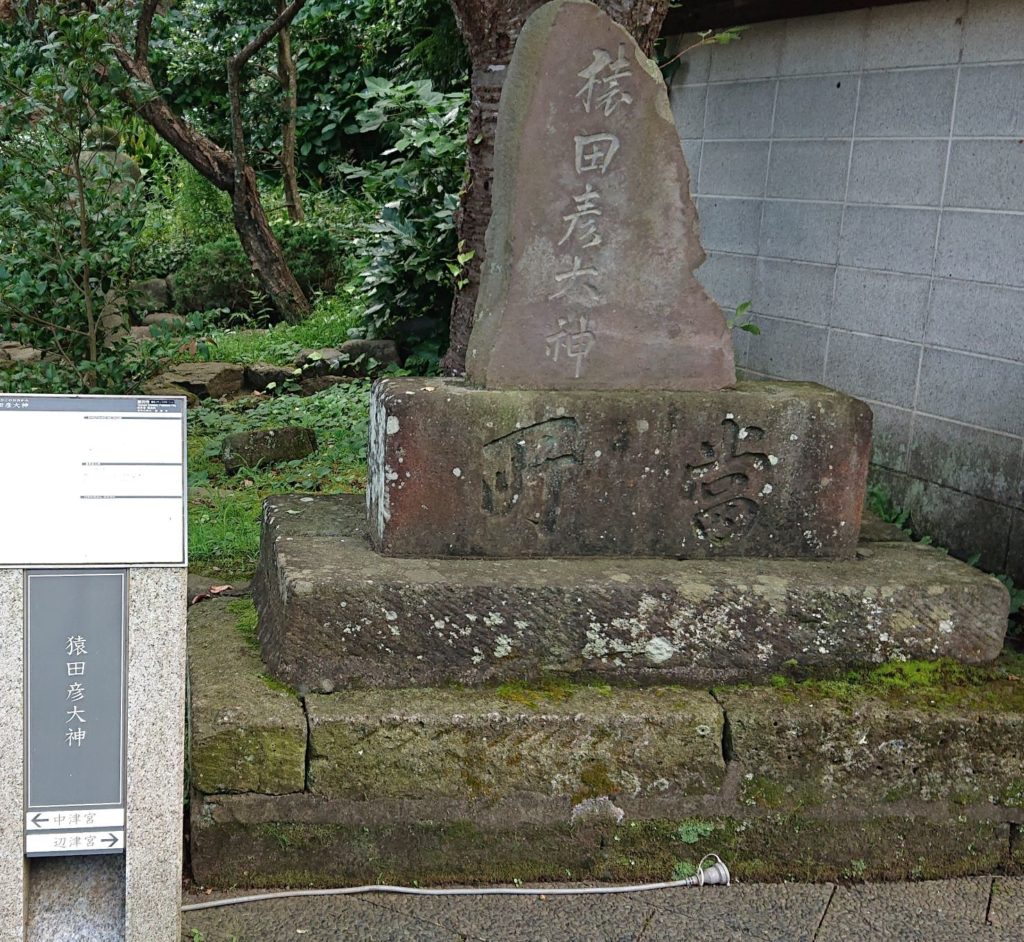
■みどりの広場 / Midori no Hiroba (Green Square)
「みどりの広場」には、花壇に季節の花が植えられています。その傍に、展望台があり、江の島の灯台とヨットハーバーとその先に腰越の街を一望できます。
Seasonal flowers are planted in the flower beds in the “Green Square”. Next to it, there is an observatory, overlooking the Enoshima lighthouse, yacht harbor and the city of Koshigoe over the sea.

■中津宮 / Nakatsumiya
昔「上之宮」と言われていた、「中津宮」です。
It is “Nakatsumiya”, which was once called “Kaminomiya”.
市寸島比賣命(いちきしまひめのみこと)をお祀りしています。
It is enshrined Ichikishima Hime no Mikoto, .
参道の両側には、江戸歌舞伎「市村座」と「中村座」が奉献した一対の石燈籠があるそうで、当時の歌舞伎役者の手形も残されているそうです。
It seems that there are a pair of stone lanterns dedicated by the Edo Kabuki “Ichimuraza” and “Nakamuraza” on both sides of the approach, and the handprints of the Kabuki actors at that time are also left.
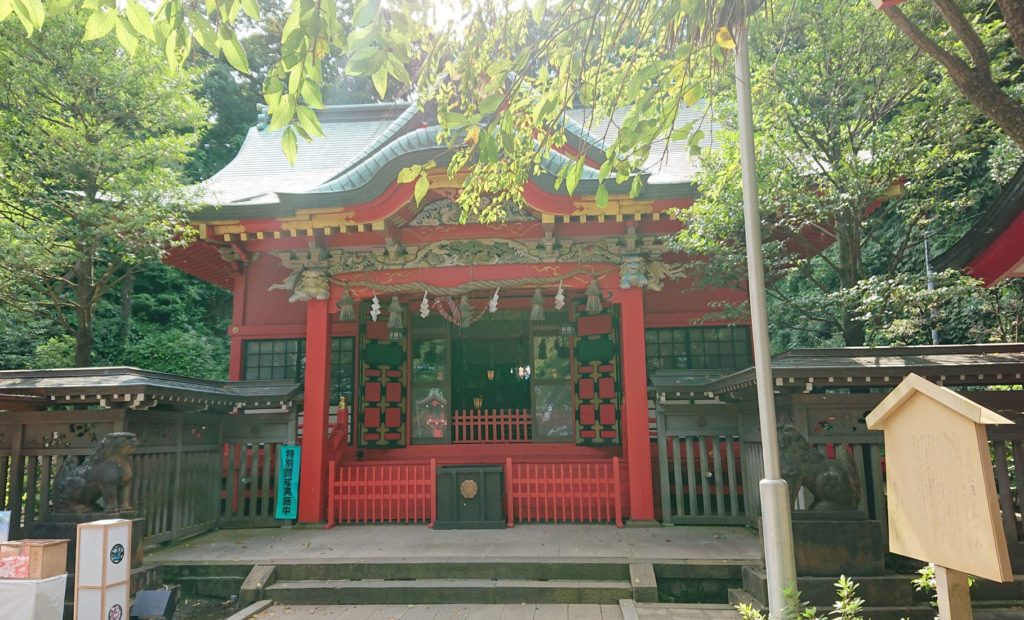
■江の島サムエル・コッキング苑と江の島シーキャンドル / Samuel Cocking Garden and Enoshima Sea Candle
頂上に着くと、視界が広がり、「江の島サムエル・コッキング苑(HP)」の休憩所があります。
When you reach the top, you have a wide view and there is a rest area for “Enoshima Samuel Cocking Garden”.
「江の島サムエル・コッキング苑」は、和洋折衷で南国ムード溢れる植物園で、四季折々様々な花や植物をお楽しめます。
“Enoshima Samuel Cocking Garden” is a botanical garden full of Japanese and Western eclectic and tropical mood, where you can enjoy various flowers and plants every season.

また、そこを抜けると、「江の島シーキャンドル」として親しまれている展望灯台が聳え立っています。今回は、外からの撮影です。江ノ電開業100周年(2002年)に合わせ、2003年にリニュアルされています。
Moreover, when you pass through it, the observation lighthouse, which is popularly known as “Enoshima Sea Candle”, stands up. This time it was taken from outside. It was renewed in 2003 to coincide with the 100th anniversary of Enoden’s opening (2002).
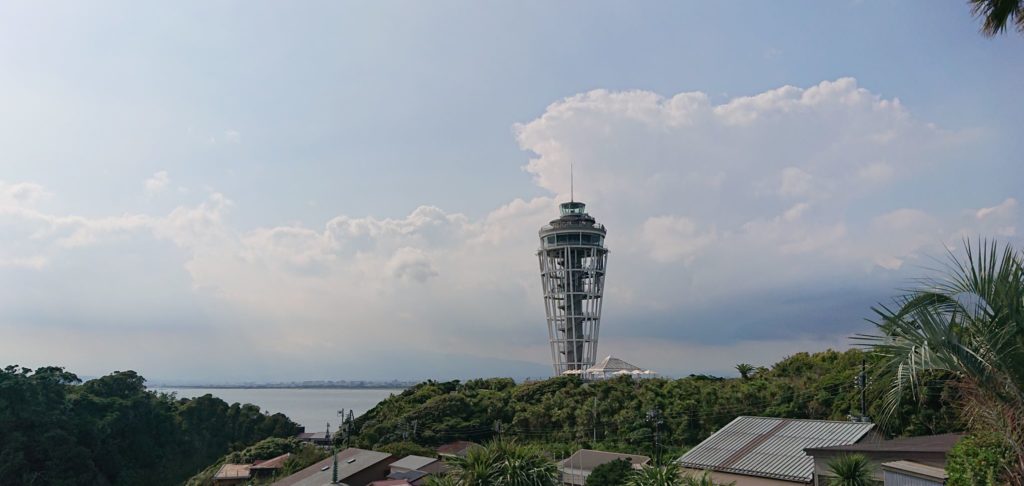

■江の島大師 / Enoshima Daishi
「江の島大師」は、1993年に最福寺 (鹿児島市)の関東別院として創建された。本尊は不動明王。室内像としては国内最大の高さ6m。別名赤不動と呼ばれている。ともともは、814年には弘法大師空海が岩屋に参拝し社殿を創建したとのを起源とする神仏習合の金亀山与願寺があったが、明治維新期の廃仏毀釈や神仏分離令で、寺は廃止されていた。その寺を復活させた形である。
“Enoshima Daishi” was established in 1993 as the Kanto annex of Saifukuji Temple (Kagoshima City). The principal image is Fudo Myo, 6m height, it is the tallest indoor image in Japan. Also known as Red Fudo. At the same time, there was the Kingameyama Yoganji Temple, combined Shinto-Buddhism that originated from the fact that Kobo Daishi (Kukai) visited an Iwaya in 814 and built a shrine. The temple was abolished at Meiji era to separate Buddism from Shinto. It is a form of resurrecting the temple.
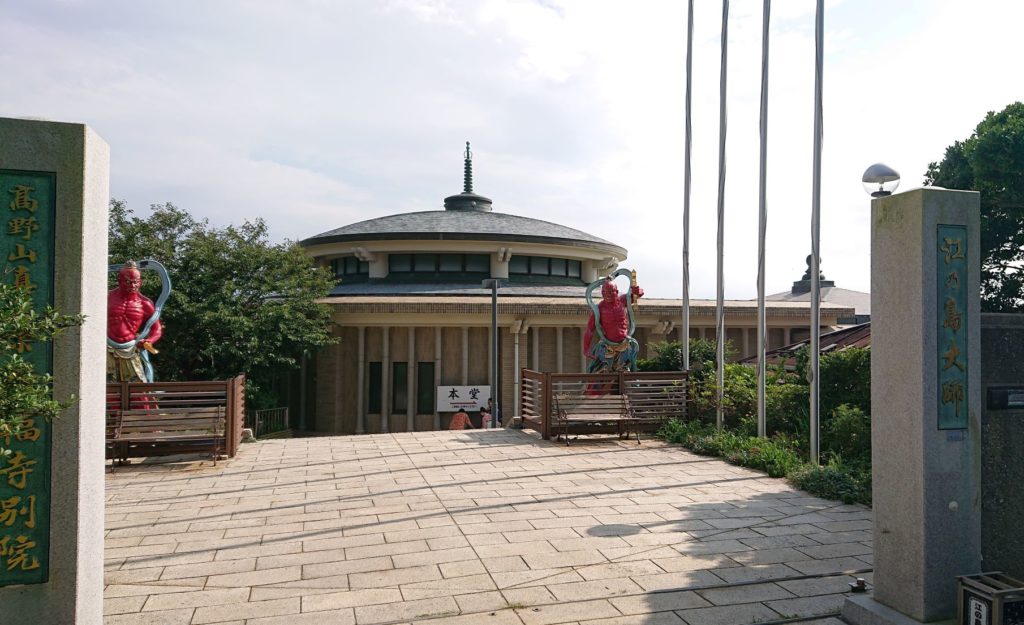
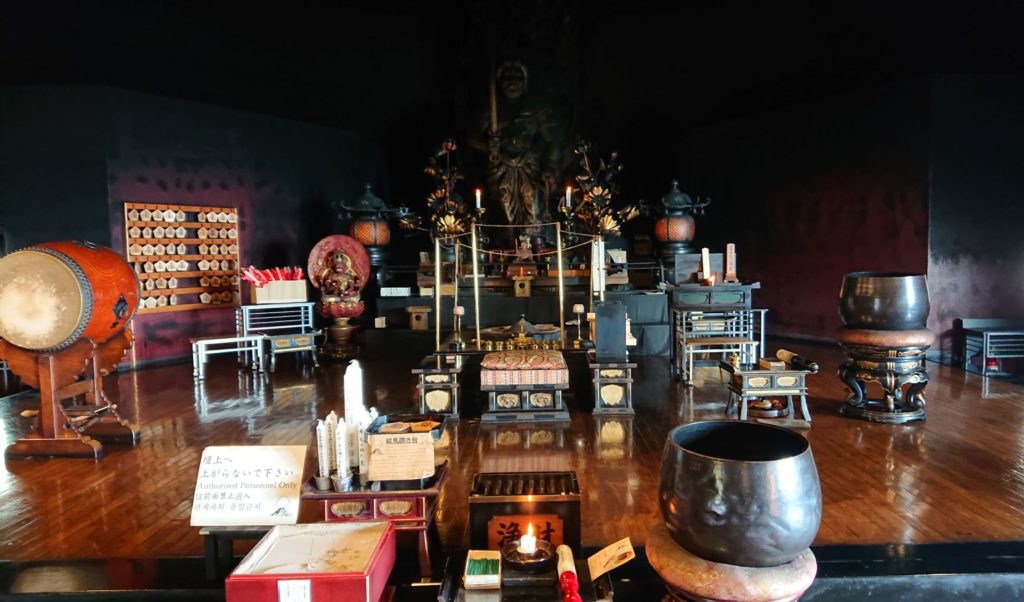
■山二つ / Two Mountains
「山二つ」は、大きな海食洞の天井部分が陥没した跡。上から見ると瓢箪のようにくびれ、ちょうど山が2つあるように見えている。ここを覗くと、吸い込まれる感覚で、スリル満点です。特に、波が荒い時は、迫力があります。
“Two mountains” is a mark of the collapse of the ceiling of a large sea cave. From the top, it looks like a gourd and looks like it has two mountains. Looking down here, it is a thrilling feeling as if you are sucked in. Especially when the waves are rough, it is powerful.
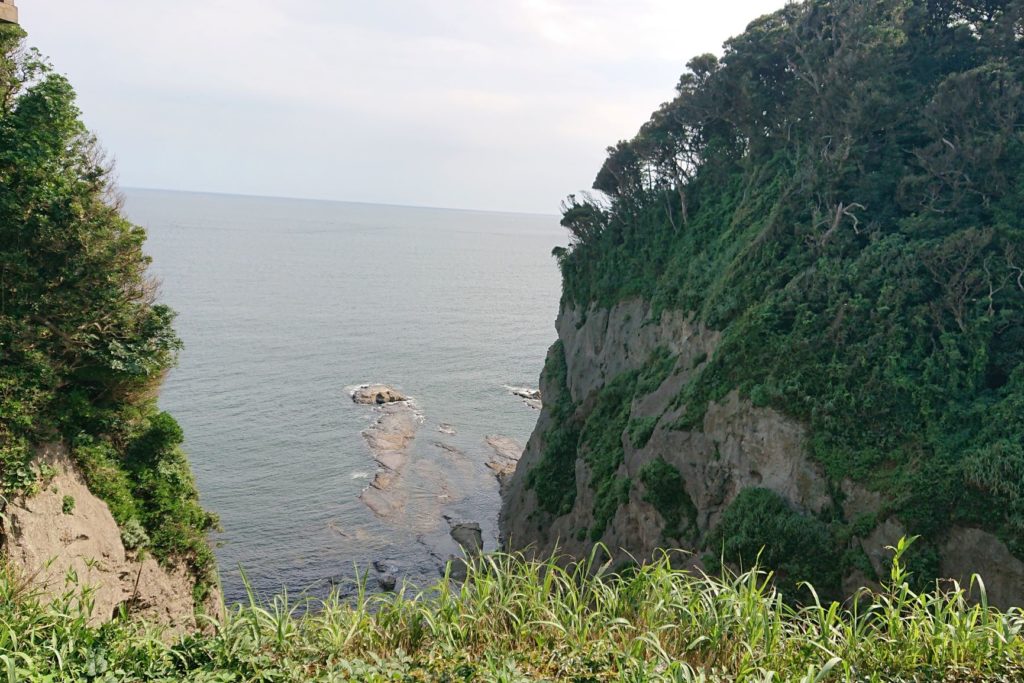
■奥津宮 / Okutsumiya
昔「岩屋本宮」と呼ばれていた「奥津宮」。
“Okutsumiya” used to be called “Iwaya Hongu”.
3姉妹の長女である多紀理比賣命(たぎりひめのみこと)が祀られています。
The eldest daughter of the three sisters, Tagiri Hime no Mikoto, is enshrined.

「奥津宮」の「手水舎」は、亀です。亀の口から水が出ています。ここは、使えます。
The “Temizuya” to purify in “Okutsumiya” has a symbol of turtle. Water is coming out of the turtle’s mouth. You can use it here.

奥津宮に向かって右側の燈籠には竜宮の乙姫、左側の燈籠には亀に乗った浦島太郎が精巧に掘り出されています。
Otohime of Ryugu is in the lantern on the right, and Taro Urashima, who rides on a turtle in the lantern on the left, are elaborately sculptured .
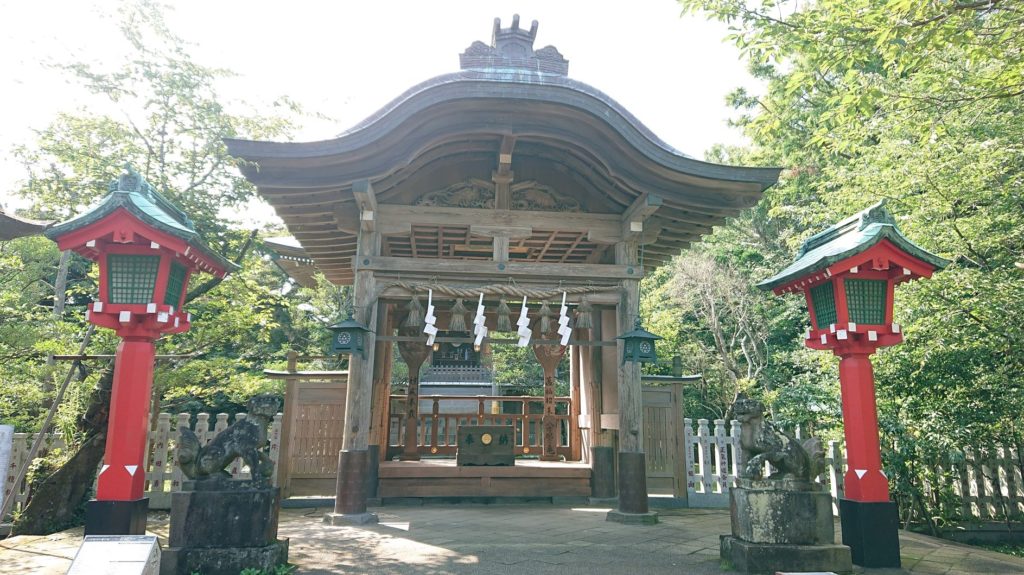
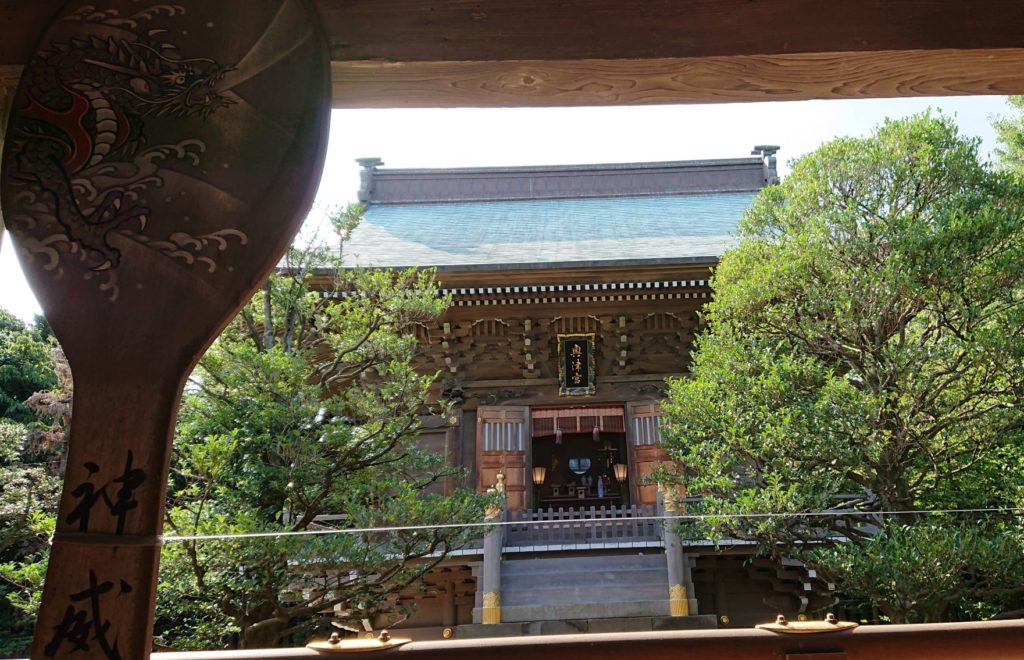
■龍宮 / Ryugu
御祭神は龍宮大神。1993年に建てられた宮。龍は、江の島誕生以来、信仰の対象となり弁財天信仰と習合してきたものです。
The deity is Ryugu Daijin. A palace built in 1993. Since the birth of Enoshima, the dragon has become a target of worship and has been associated with the Benzai faith.

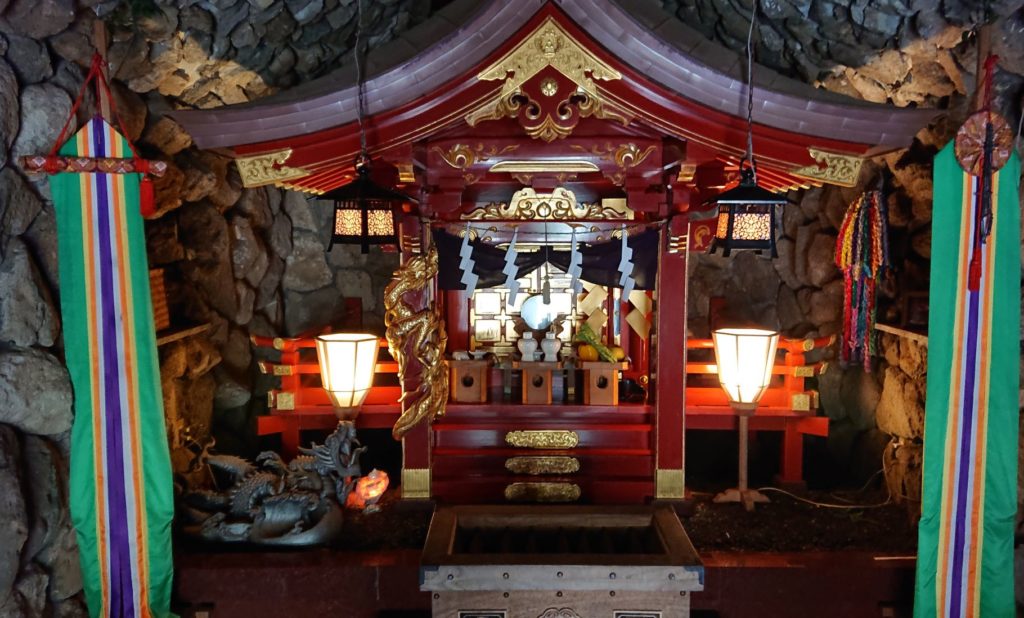
■龍恋の鐘 / Bell of Dragon’s love
「龍恋の鐘」は、1996年にできました。
“Ryuren no Kane (Bell of Dragon’s love)” was created in 1996.
当時、底なし沼で子供を生贄にし、子死越と恐れられていた五頭龍が、天地振動の際に現れた天女(弁財天)に恋をし、心を改めたと伝説から来たものらしいです。この改心した五頭龍は、腰越にある「瀧口明神社」に祀られている。
At that time, it seems that the legend says that 5 heads dragon, who was afraid of child death in a bottomless swamp, fell in love with the heavenly maiden (Benzaiten) that appeared during the ups and downs, and changed his mind. This converted 5 heads dragon is enshrined in the “Takiguchi myo Shrine” in Koshigoe.
ご覧のように、二人の名前を書いた南京錠がいっぱいです。「この鐘を鳴らした二人は決して別れない」と言われ、「陽だまりの彼女」(映画)のロケ地にもなりました。
As you can see in the picture, there are a lot of padlocks with the names of the lovers (male and female). It was said that “the lovers who ring this bell would never separate”, and it was also used as the location for “Hidamari no Kanojo” (movie).

■稚児ケ淵 / Chigogafuchi
「稚児ケ淵(HP)」は、江の島の隆起現象でうまれた海食大地。かつて、稚児の白菊がここから身を投げたことからついた名前とのことです。
“Kagogafuchi” is a sea caved land created by the uplifting phenomenon of Enoshima. It is said to have been given the place name derived from the child name, Shiragiku who threw herself from here.
ここは、富士山の向こうに沈む夕日の美しさで有名です。この日は、雲で生憎富士山は拝めませんでした。一方、磯釣りの名所としても知られ、この日も多くの太公望が楽しんでいました。
This place is famous for the beauty of the sunset over Mt. Fuji. On that day, I couldn’t see Mt. Fuji because of the clouds. On the other hand, it is also known as a famous spot for surf fishing, and it was enjoyed by many anglers.
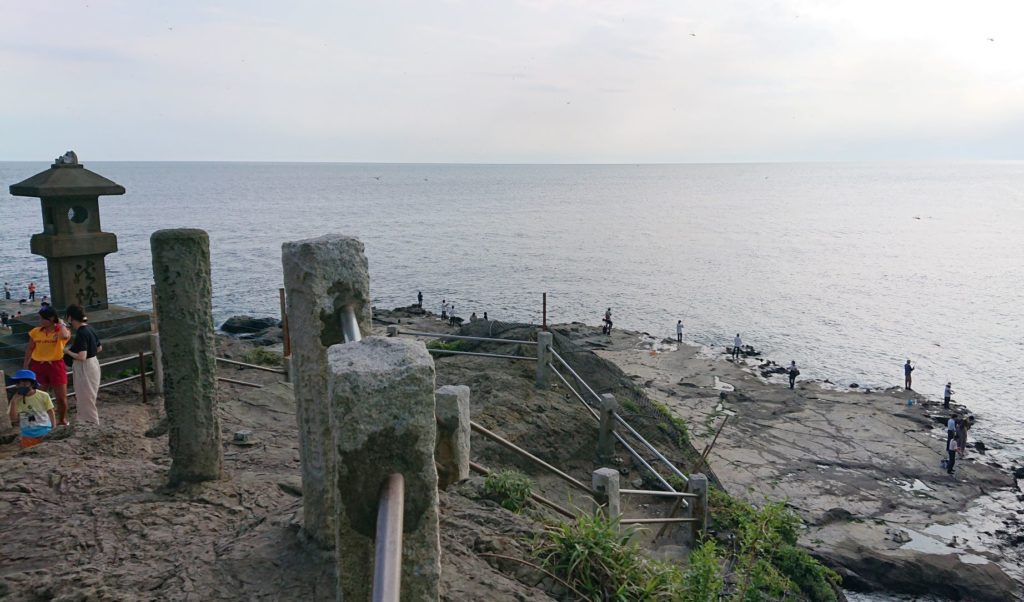
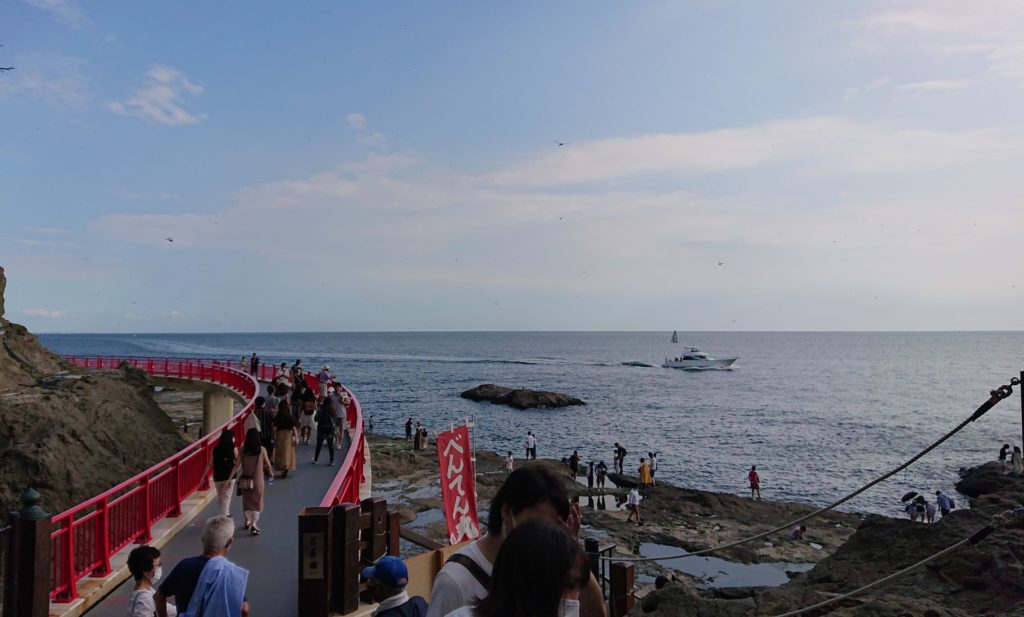
■江の島岩屋 / Enoshima Iwaya
「江の島岩屋」の洞窟は、大きく2か所あります。
There are two large caves at “Enoshima Iwaya”.
2か所合わせて、入場料500円(大人)、200円(子供)。
Admission is 500 yen (adult) and 200 yen (child) for the two caves.
この日は、夏日だったため、洞窟の中は、非常に涼しく、まさに天然クーラーで、生き返りました。コロナ対策で、マスクの着用、ソーシャルディスタンスの制限がありました。
It was a summer day, so the inside of the cave was very cool, and it was just a natural cooler and it revived me. As a measure against corona, there were restrictions on wearing masks and social distance.
ここ岩屋の洞窟は、私にとって3回目なのですが、この暑さと、このブログのために写真を撮りたいということで、入場しました。
I have been to the Iwaya cave the third time, but I entered here because of this heat and the purpose that I wanted to take a picture for this blog.
第一岩屋です。
This is the first Iwaya.
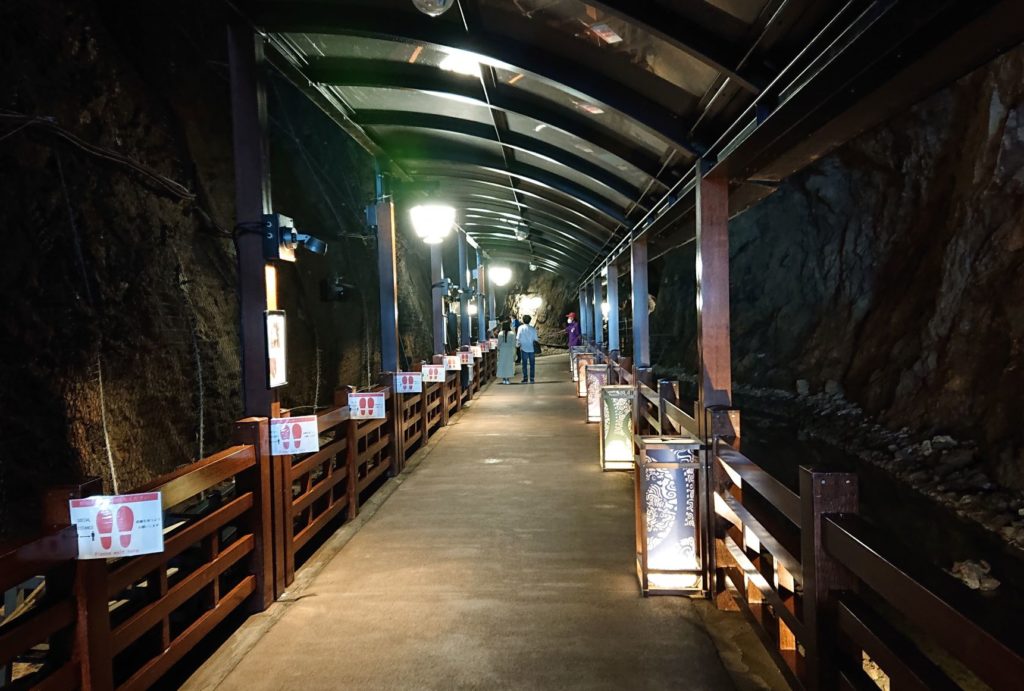
与謝野晶子の歌「沖つ風 吹けばまたゝく 蠟の灯に 志づく散るなり 江の島の洞」。
The song by Akiko Yosano, “Okitsu Kaze Fukeba Mattaku Ro no Hini Shizuku Chirunari Enoshima no Do” (At the cave in Enoshima, if the wind blows off the sea, the candle lights will flicker and the drops will be scattered.”)

ここで二股に別れます。いずれも、高さは低く、私は、背を屈めて通るところが多いです。子供は、怖がっているようでしたが、暗いだけで、特に怖い話があるところではないと思います。
The path splits up here in two. Both of them are low in height, and I often bend my back. The child seemed scared, but I don’t think there’s anything particularly scary about it, just because it’s dark.
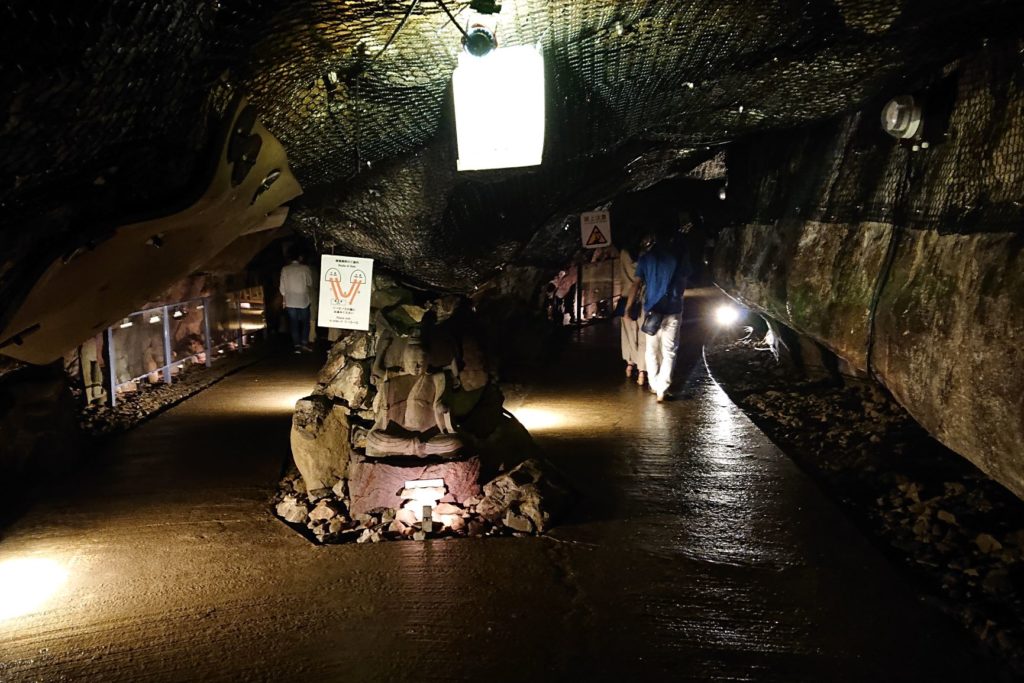
下写真にある穴のこの先、富士山の氷穴とつながっていると言われているが、どうなのでしょう?信じてみたいけど、隆起してできた江の島だから70kmの距離が繋がっているとは思えないな。
It is said that the hole in the photo below is connected to an ice hole on Mt. Fuji, but what about? I want to believe it, but I don’t think it is not real because it’s a 70km distance between Enoshima and Mt.Fuji and Enoshima is also raised island.

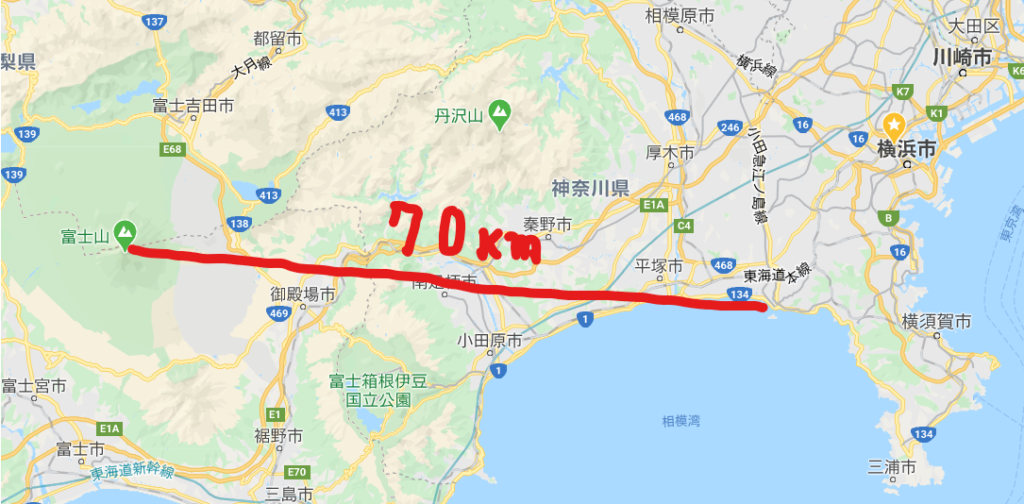
日蓮上人の寝姿のような形をした石(左)。
A stone shaped like the sleeping figure of a Nichiren Superior (left).
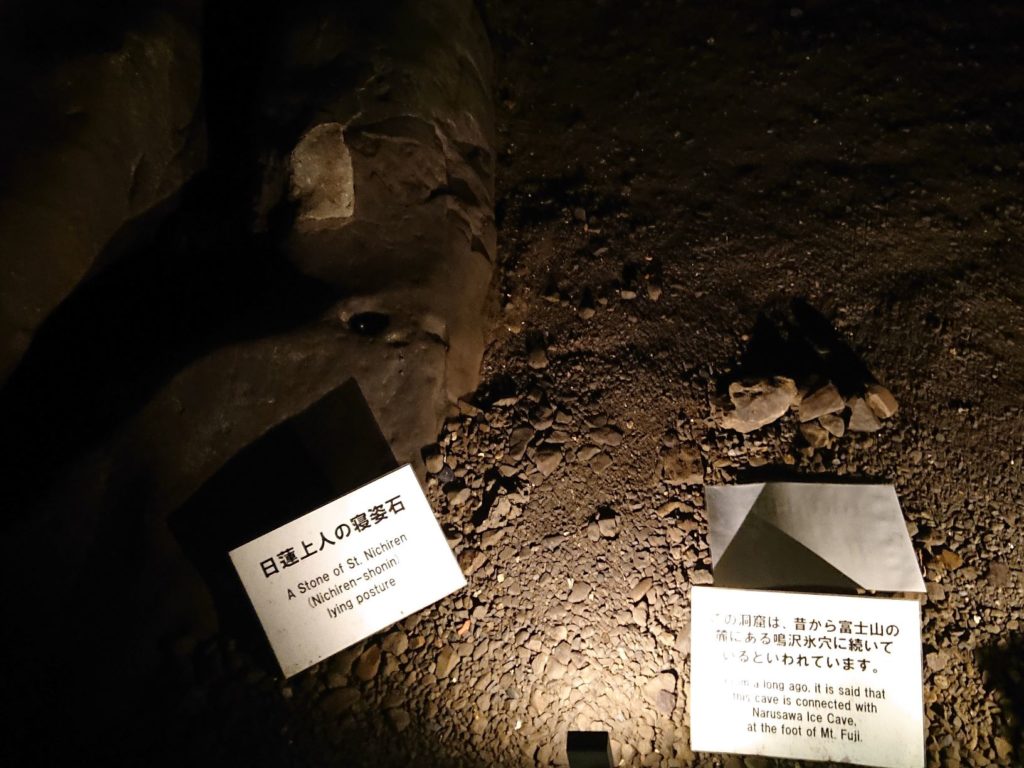
「江島神社の発祥の場所」とされているところ。多くの高僧や武将がここを訪れて祈願のため籠ったことを「江の島参籠」といっていたそうです。昔は、海水が入ってくる間は、ここの神様を山の上の御旅所(奥津宮)に移していたと伝えられています。
It is said to be the “place of origin of Ejima Shrine”. It is said that many high priests and warlords visited here and prayed for long time. It was called “Enoshima Sanro.” It is said that in the old days, the gods here were moved to the Okutsumiya temporarily on the mountain while the seawater came in.

第二岩屋にあるアトラクションの龍です。洞窟には、スピーカーが設置され、時折、龍が唸る声が洞窟内に響き渡ります。(動画の方が良かった)
It is an attraction dragon in the second Iwaya. Speakers are installed in the cave, and the roar of the dragon occasionally echoes in the cave. (The video was better than the below picture)

■まとめ
目的は、「鎌倉江ノ島七福神」の一人「弁財天」が祀られている「江島神社」の参拝でしたが、結果的には、久しぶりの江ノ島観光になりました。休憩もせずテンポよく一通りの観光スポットに行きましたが、江ノ島駅に戻ってくると2時間半かかっていました。途中、洞窟で涼めましたが、暑くて疲れました。
The purpose was to visit the “Enoshima Shrine” where “Benzaiten”, one of the “Kamakura Enoshima Seven Lucky Gods”, is enshrined. As a result, this day was attractive visit to many places in Enoshima since a long miss. I went to one of the most popular tourist spots without a break, but it took two and a half hours when I returned to Enoshima Station. On the way, I cooled in a cave, but it was hot and I was tired.
もっとも印象に残ったのは、やはり、初めて見た「八臂弁財天」と「裸弁財天・妙音弁財天」です。後宇多天皇(ごうだ)から賜った「江島大明神」の本物も良い感じでした。
The things that left the most impression on me are the “Happi Benten” and “Naked Benten/Myoon Benten” that I saw for the first time. The real plate of “Ejima Daimyojin” given by Emperor Gouda was also good.



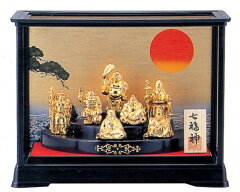

この記事へのコメント